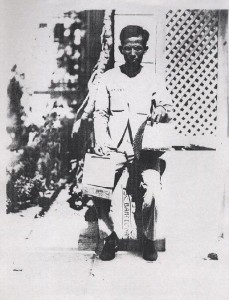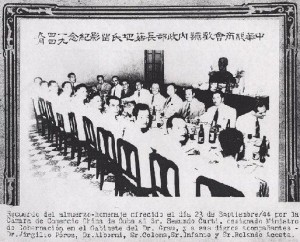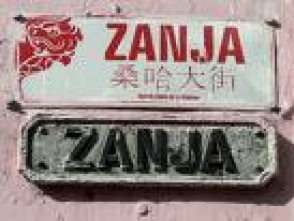The presence of Chinese in Cuba in historical documents dates back to the year 1850. These documents show that they were elected to public offices in the city of Havana, were employed, and participated in Cuban society.
EVIDENCE
The title of the oldest document examined in the Jose Martí National Library in Havana, Cuba is titled: “Copia de un contrato entre colono chino y el español”. It is not classified by the library under the name of the author but rather under the category “Chinos en Cuba”. The document was written around the year 1850 and it consists of seven illegible pages registered as C.M. Escoto No. 247. Following the same format of the classification and its correspondence with the name of the author in the second and third oldest documents, one might conclude that Escoto is the name of the author. From this information one might also deduce that as early as the 1850 there were Chinese in Cuba that were already colonists and that they conducted business with the Spaniards in Havana. One can only conjecture as to what type of business was conducted. The Chinese colonist probably worked in agriculture. The Spaniard, most likely of the upper class, was a merchant and this indicates the nature of the contract: an agreement between a Chinese agriculture laborer of the lower class and a Spanish merchant of the upper class. The specifics of the contract are unknown due to the illegibility of this poorly preserved document. One conclusion about this document is that the Chinese had already gained legal recognition by obtaining such a contract even though the Spaniard initiated the writing of the document for his own purposes.
The title of the second oldest document found is: “Chinos en Cuba Oficios”written by Martín Iraizoz. The last name of the author is not of Spanish origin but appears to be a misspelled Chinese surname, registered as C.M. Iraizoz No. 328. It was published in the year 1861, and is two pages long. The title indicates the existence of offices for Chinese in Cuba. What were the offices? Who were the Chinese that occupied these offices and what distinct characteristics did these individuals possess? How much importance did these offices have in Cuban society? It is notable that a Chinese man probably wrote this document. It indicates that there was at least one Chinese man literate in the Spanish. Language.
The title of a third set of documentation “China: Relaciones Exteriores”is attributed to (Grau San Martín) Curti Messina. This collection consists of five empty envelopes that are numbered from one to five. Registered as FC Curti (Col. Pre.) this collection of envelopes indicates that communications existed between people in China and Cuba. It is not known whether the contents of the envelopes were an actual correspondence or if they were written to describe the communications that occurred. Since the envelopes bear illegible inscriptions, it seems most likely that they contained a series of correspondences. The likelihood is small that there were many people in China that spoke Spanish. Thus, it is likely that, if there was actual correspondence, it would have been with a Chinese individual in Cuba, and the document would have been written in a Chinese dialect, or there was correspondence with someone traveling to Cuba. The theory that there was actual correspondence with a Chinese person is appealing because the Chinese immigrants in Cuba would have wanted to communicate with their families in China.
In the article, “Los Chinos de Cuba” published by El Figaro, a Cuban writer, R. A. Catalá describes the arrival of the “Hai Chi” which was a Chinese naval war ship used in the Opium wars with Britain, entering the port at the Malecón in Havana, Cuba. Catalá describes the experience of seeing the “Hai Chi” as having an anxious effect on the crowd complete with “explosiones de entusiasmo”. The Chinese-Cubans, a population at the time of 10,000, were on hand to greet their compatriots who had arrived on their shores. Not only does Catalá write about the enthusiasm of the Chinese people, but he also mentions the prejudices that the Chinese-Cubans faced, and how the arrival of the “Hai Chi” produced more speculation from Cubans, instead of acclaim. Catalá compares the arrival of the “Hai Chi” naval ship with the arrival of the “Nautilus,” a Spanish ship that arrived on Cuba’s shores 4 years previous to the “Hai Chi.” The receptions were quite different as one can imagine.
Chinese-Cubans at the time were the most economically poor and under-class among the races/cultural ethnic groups in Cuba, the rich and wealthy being the Cubans of Spanish descent, “los cubanos hijos de los españoles.” The author states that this was logical because of the economic status of the “Spanish-Cubans” who were and are, on average, more wealthy than any other racial/ethnic group in Cuba, and who also enjoy a greater population in Cuba in comparison to the Chinese-Cubans. “Es cuestión de número y raza.” The author also argues that the question is not solely limited to race and population, but also to the economic history of the first Chinese who have arrived in Cuba. They arrived from Hong Kong around the year 1847 to work in the Cuban fields as contracted day laborers, hoping to earn enough money to send to their families in China, and to possibly return to China with more money. This contract, however, turned out to be more like a contract for slavery.
The Cuban government in connection with the Chinese government, used these Chinese immigrants as “beasts of burden” and not only isolated them to work in the most horrible conditions, but selected the inhospitable and infertile land for them to reside and to live. It was, as described by Catalá, a “verdadera esclavitud”, and the Chinese were seduced into toiling the Cuban lands and beaches, but arrived and were instead greeted with a different reality than promised. Also, most of the Chinese arriving in Cuba from China were sick with infections and fevers caused by the voyage, and were later thrown to one side to be placed in the more infectious Cuban hospitals. The reasonably healthy Chinese were marched to the fields outside of the city where conditions were poor and the small huts, barracones, offered to the Chinese were dirty and uncomfortable. Because of the awful conditions of the Chinese in Cuba at the time, many committed suicide, were put into insane asylums, and the majority experienced injuries while working, Deformities were common, and workers were badly treated by the land owners.
Since the time Catalá wrote this article, October 1911, the situation of the chinos-cubanos has changed. Not only did they produce their own homes and businesses, but also grew politically and has gained diplomatic representation. For example the photo in the right corner of p.611 of the Hijos Del Celeste Imperio Residentes de La Habana, who are responsible for organizing festivals in honor of the landing of the “Hai Chi” represents Chinese-Cubans’ growing political force (1955). Chinese-Cubans even have their own special cemetery in Havana; however many Chinese-Cubans send the remains of their loved ones to China for burial. Catalá’s article demonstrates the incredible transformation of the economic and political situation of the Chinese-Cubans, who have undergone disease and the perils of slavery, to progress to a highly respected, relatively prosperous and unique community culture within Cuba.
The Chinatown of Havana before the Cuban revolution became the most important and prosperous of all Latin America. The Chinatown of Havana today is far from that giant mall.
ChineseLife/Brainard/Catala1911/Blackhouse/InternetPhotos/TheCubanHistory.com
HISTORICAL CHINESE presence in Cuba . Evidence
The Cuban History, Hollywood.
Arnoldo Varona, Editor
Habana vista desde La Cabaña
FOTO por Roberto Suárez, Alejandro de la Torre, Niurka De La Nuez, Tania Castells Rodriguez and Ihosvanny Hernandez Artiles.

PRESENCIA HISTÓRICA CHINA en Cuba. Evidencias
La presencia de China en Cuba en los documentos históricos se remonta al año 1850. Estos documentos demuestran que fueron elegidos para cargos públicos en la ciudad de La Habana, fueron contratados, y participó en la sociedad cubana.
PRUEBAS
El título del documento más antiguo examinados en la Biblioteca Nacional José Martí en La Habana, Cuba se titula: “Copia de las Naciones Unidas Contrato Entre colono chino y El Español”. No está clasificado por la biblioteca con el nombre del autor, sino más bien en la categoría de “Chinos en Cuba”. El documento fue escrito alrededor del año 1850 y que consta de siete páginas ilegibles registrados como CM Escoto N º 247. Siguiendo el mismo formato de la clasificación y su correspondencia con el nombre del autor en los documentos más antiguos de la segunda y tercera, se podría concluir que Escoto es el nombre del autor. De esta información también se puede deducir que ya en el 1850 había china en Cuba, que ya eran colonos y que se llevó a cabo negocios con los españoles en La Habana. Uno sólo puede conjeturar sobre qué tipo de negocio se llevó a cabo. Los colonos chinos probablemente trabajaba en la agricultura. El español, muy probablemente de la clase alta, era un comerciante y esto indica la naturaleza del contrato: un acuerdo entre un trabajador de la agricultura china de la clase baja y un comerciante español de la clase alta. Los detalles del contrato no se conocen debido a la ilegibilidad de este documento en mal estado. Una de las conclusiones de este documento es que los chinos ya habían obtenido el reconocimiento legal mediante la obtención de dicho contrato a pesar de que el español inició la redacción del documento para sus propios fines.
El título del documento más antiguo encontrado segunda es: “Chinos en Cuba Oficios”, escrito por Martín Iraizoz. El apellido del autor no es de origen español, pero parece ser un apellido mal escrito chino, registrado como CM Iraizoz N º 328. Se publicó en el año 1861, y es de dos páginas. El título indica la existencia de oficinas de China en Cuba. ¿Cuáles eran las oficinas? ¿Quiénes fueron los chinos que ocupaban estas oficinas y qué características distintas poseían estas personas? ¿Qué importancia tuvo estas oficinas tienen en la sociedad cubana? Es notable que un hombre chino probablemente escribió este documento. Se indica que hubo al menos un hombre chino de leer y escribir en el español. Idioma.
El título de un tercer juego de la documentación “China: Relaciones Exteriores” se atribuye a (Grau San Martín) Curti Messina. Esta colección se compone de cinco sobres vacíos que están numerados del uno al cinco. Registrado como FC Curti (Col. Pre.) De esta colección de sobres indica que la comunicación existente entre la gente en China y Cuba.
En el artículo, “Los Chinos de Cuba”, publicado por El Fígaro, un escritor cubano, R.A. Catalá describe la llegada de la “Hai Chi”, que era un barco de guerra naval china utilizada en las guerras del Opio con Gran Bretaña, entraba en el puerto en el Malecón de La Habana, Cuba. Catalá se describe la experiencia de ver el “Hai Chi” que tienen un efecto sobre la multitud ansiosa completa con “explosiones de Entusiasmo”. El cubano-chinos, una población en el momento de 10.000, estuvieron presentes para saludar a sus compatriotas que habían llegado a sus costas. No sólo Catalá escribir sobre el entusiasmo del pueblo chino, sino que también menciona los prejuicios que los chinos, los cubanos se enfrentan, y cómo la llegada de la “Hai Chi” produjo más la especulación de los cubanos, en lugar de elogios. Catalá se compara la llegada de la “Hai Chi” buque de guerra con la llegada de la “Nautilus”, un barco español que llegó a las costas de los 4 años anteriores a la de Cuba “Hai Chi”. Las recepciones eran bastante diferentes, como se puede imaginar.
Cubano-chinos en el momento eran los más pobres económicamente y en la clase entre las razas y grupos étnicos culturales en Cuba, los ricos y los ricos son los cubanos de ascendencia española, “Los Hijos de Cubanos Españoles Los.” El autor afirma que este era lógico debido a la situación económica de los “españoles-cubanos” que fueron y son, en promedio, más ricos que cualquier otro grupo racial / étnico grupo en Cuba, y que también disfrutan de una mayor población en Cuba en comparación a los chinos-cubanos. “Es Cuestión de numero y raza.” El autor también sostiene que la cuestión no se limita únicamente a la raza y la población, sino también a la historia económica de los primeros chinos que han llegado a Cuba. Llegaron desde Hong Kong hacia el año 1847 a trabajar en los campos cubanos como jornaleros contratados, con la esperanza de ganar suficiente dinero para enviar a sus familias en China, ya regresar a China, posiblemente, con más dinero. Este contrato, sin embargo, resultó ser más parecido a un contrato de esclavitud.
El gobierno cubano en relación con el gobierno chino, que se utiliza a estos inmigrantes chinos como “bestias de carga” y no sólo aisló a trabajar en las condiciones más horribles, pero seleccionó la tierra inhóspita y estéril para ellos a residir y vivir. Era, como se describe en Catalá, una “Verdadera Esclavitud”, y los chinos estaban trabajando duro seducido a las tierras cubanas y las playas, pero llegamos y nos saludó en cambio con una realidad diferente de lo prometido. Además, la mayoría de los chinos de llegar a Cuba procedentes de China estaban enfermos de infecciones y fiebres causadas por el viaje, y más tarde fueron arrojados a un lado para ser colocado en los hospitales cubanos más infecciosas. El razonablemente saludable china se marcharon a los campos de las afueras de la ciudad, donde las condiciones eran pobres y las pequeñas chozas, los barracones, que se ofrecen a los chinos estaban sucios e incómodos. Debido a las terribles condiciones de los chinos en Cuba en el momento, se suicidó a muchos, fueron puestos en manicomios, y las lesiones la mayoría con experiencia durante el trabajo, deformidades eran comunes, y los trabajadores fueron maltratados por los dueños de la tierra.
Desde el momento en Catalá escribió este artículo, octubre de 1911, la situación de los chinos-cubanos ha cambiado. No sólo producen sus propios hogares y las empresas, pero también creció políticamente y se ha ganado la representación diplomática. Por ejemplo, la foto en la esquina derecha de la p.611 del Celeste Imperio Hijos Del Residentes de La Habana, que se encargan de organizar las fiestas en honor de la llegada de la “Hai Chi” representa la fuerza cubano-chinos “política cada vez mayor (1955 ). Cubano-chinos tienen su propio cementerio en La Habana, sin embargo muchos chinos-cubanos envian los restos de sus seres queridos a China para su entierro. El artículo Catalá demuestra la increíble transformación de la situación económica y política de los cubanos-chinos, que han sido sometidos a las enfermedades y los peligros de la esclavitud, para pasar a un muy respetado, la cultura de la comunidad relativamente próspera y única dentro de Cuba.
El Barrio Chino de la Habana antes de la revolucion cubana llego a ser el mas importante y prospero de toda America Latina. El Chinatown de la Habana hoy dista mucho de ser aquel gigantesco centro comercial.
ChineseLife/Brainard/Catala1911/Blackhouse/InternetPhotos/TheCubanHistory.com
HISTORICAL CHINESE presence in Cuba . Evidence
The Cuban History, Hollywood.
Arnoldo Varona, Editor



 HISTORICAL CHINESE presence in Cuba . Evidence (Photos) * * PRESENCIA HISTÓRICA CHINA en Cuba. Evidencias (Fotos).
HISTORICAL CHINESE presence in Cuba . Evidence (Photos) * * PRESENCIA HISTÓRICA CHINA en Cuba. Evidencias (Fotos).


